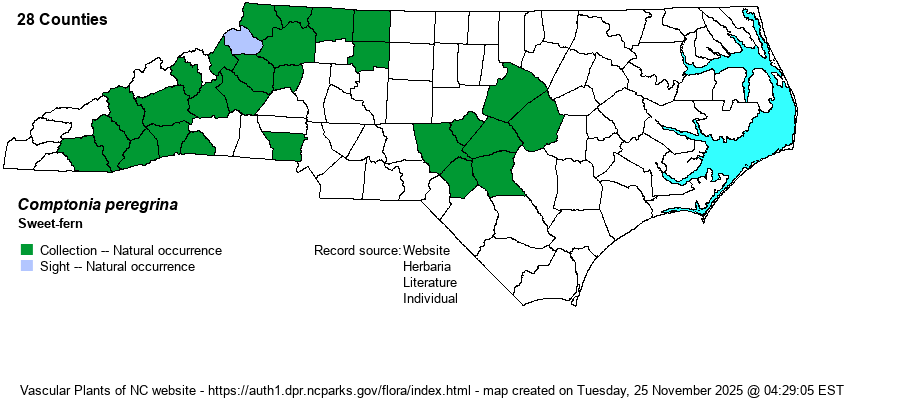| Author | (L.) Coulter | |
| Distribution | A disjunct range in the state, but primarily in the Mountains, where found in most counties but scarce to absent in the far southwest. It also occurs in the nearby western Piedmont foothills, mainly on monadnocks. It then is disjunct to a small area on both sides of the Fall Line, where recorded from 7 counties from Wake on the north to Hoke and Cumberland on the south.
This is a species ranging far northward well into Canada, and then south only to NC, northwestern SC, and northeastern GA. There is a small disjunction in the Cumberlands of KY and northern TN.
| |
| Abundance | In the Mountains, uncommon and declining, owing mainly to fire suppression. Rare to uncommon in the Piedmont foothills, but very rare along the Fall Line, where it is clearly rarer than in previous decades (current pops on Fort Bragg). This is an NC Watch List species. | |
| Habitat | This is a species of xeric, often rocky or sandy roadbanks; xeric pine/oak forests and edges, and clearings, mostly on steep ground such as on ridges. Along the Fall Line, it is found mainly on thin sandy soil on slopes and bluffs, in pine stands. Most habitats are traditionally fire-prone, and the species likely requires periodic fire for its long-term survival. |
| Phenology | Blooms in April; fruits in August and September. | |
| Identification | This is a low growing colonial shrub with deciduous, alternate leaves. Plants are normally only 1-3 feet tall and are multi-branched. They are easily identified in the growing season by the unique leaf shape –- very narrowly elliptic to linear and about 2-3 inches long, with strongly crenate/wavy undulated leaf margins. The leaves thus resemble pinnae on many ferns, leading to the common name. Seldom are just one or two plants seen; where it occurs one is likely to see a few dozen or more plants in a fairly small area. The fruit are born in clusters in a catkin. | |
| Taxonomic Comments | Essentially none, but a few varieties have been named in the past. Most recent authorities list no varieties, at least not in the far South.
| |
| Other Common Name(s) | None, though the name is variously written as Sweet Fern, Sweetfern, and Sweet-fern (our most prevalent name) | |
| State Rank | S3 | |
| Global Rank | G5 | |
| State Status | W1 | |
| US Status | | |
| USACE-agcp | | |
| USACE-emp | | |

